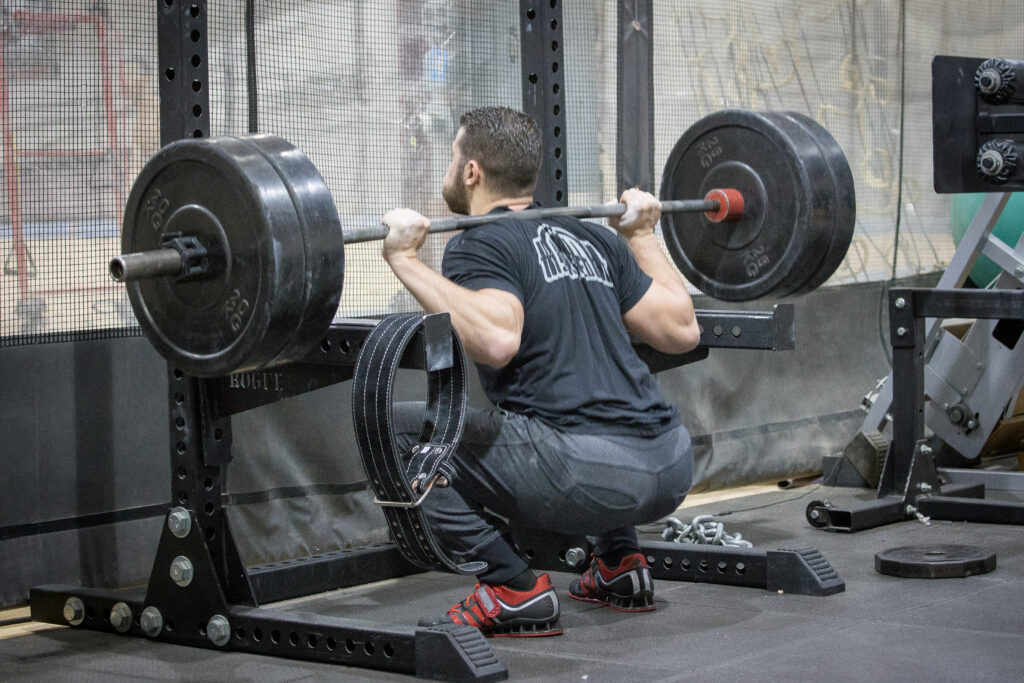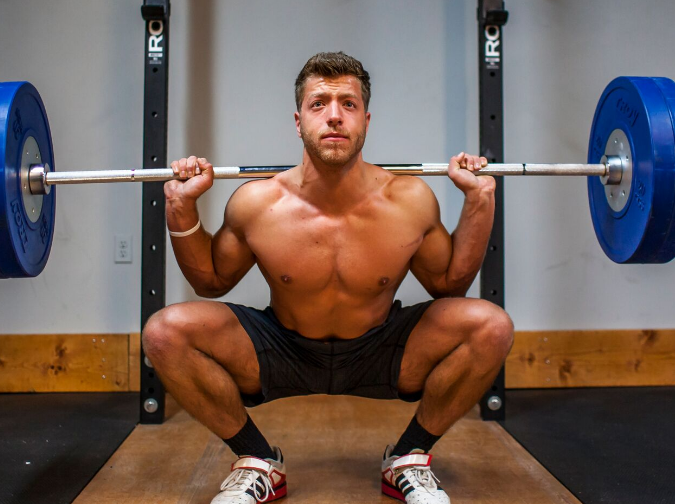A great high back squat requires four important aspects: coordination, proper movement mechanics, muscular strength, and neuromuscular efficiency.
- Coordination: The way the body moves with weight on it in a safe manner.
- Proper Movement Mechanics: ‘Good form,’ or the way the body moves synergystically to move a weight.
- Muscular Strength: The ability to hold a weight and not crumble beneath it.
- Neuromuscular Efficiency: The body’s ability to recruit the correct muscle and amount of muscle needed to match the stimulus.
Each of these play an important role to a successful squat, especially as the weight on the back increases. Strength training typically ties all of them together to improve at once, but can focus on one specific aspect. Some examples could be improving your 3-RM squat strength, or working on technique for coordination.
The high back squat can also be used as an assessment for these above traits. Research performed in 2014 & 2015 used a back squat to test deficits that limit one’s performance. They suggested looking at multiple aspects during a back squat to find deficits including…
- Inefficient motor recruitment
- Muscle weakness
- Joint instability
- Muscle tightness/Mobility issues
From their research they assessed the form of a high bar back squat. There will be differences between the above traits between low bar and high bar squats.
The goal of their research was to use a Back Squat Assessment (BSA) to provide trainers, coaches, and practitioners an effective way to address and correct deficits. Deficits limit performance, so knowing where to look and how to cue/correct them is key to one’s success.
Below are key points they point out in proper high bar squat performance, along with a deficit summary that can be used as a tool to identify where someone’s form may be lacking. Note, everyone has anthropometric differences, so take the information and cater it towards differences you assess.
Head Position
- Proper Technique: Neutral head alignment with the spine
- Common Deficits: Too much flexion/extension of the head, or tilting to the side
Gaze
- Proper Technique: Forwards or slightly upwards
- Common Deficits: Excessive downward gaze (can cause torso flexion), and excessive upward gaze (can cause strain on the neck)
Deficits Summary for Head/Gaze Position
- Neuromuscular – Poor head/neck awareness and lack of correct gaze alignment
- Muscular – Lack of strength to maintain a neutral head position
- Mobility – Poor head and neck range of motion through all three places of movement
Thoracic (mid-back)
- Proper Technique: Slight extension to provide the spine with a little rigidity with the chest pushed out and upwards (retract and depress the scapula to support an upward chest)
- Common Deficits: Extreme flexion/extension of the middle back, also, relaxed scapula
Deficits Summary for Thoracic
- Neuromuscular – Lack of ability to maintain upright chest and difficulty differentiating between proper trunk posture
- Muscular – Lack of rigid thoracic posture, which could point to lack of strength in the erector spinar
- Mobility – Tightness in the chest that may be caused by upper crossed syndrome
Trunk (lower back, obliques, abs, and quadratus lumborum)
- Proper Technique: Lumbar musculature should maintain a neutral, slightly upward rigid posture
- Common Deficits: Flexion of the trunk
Deficits Summary for Trunk
- Neuromuscular – Rounding or flexing the trunk during the squat
- Muscular – Weakness in the core and lower back musculature
- Mobility – Hip and abdominal tightness
Hips
- Proper Technique: Square, stable hips with femurs maintaining symmetrical stature and the pelvis maintaining a normal/neutral tilt
- Common Deficits: Unilateral differences in hip heights throughout the squat
Deficits Summary for Hips
- Neuromuscular – Hips are not symmetrical throughout the squat
- Muscular – Lack of ability to maintain stable symmetrical hips
- Mobility – Tight hip flexors
Knees
- Proper Technique: Knees should track over toes without caving or bowing excessively
- Common Deficits: Valgus (caving in) and Varus (bow legging) both
Deficits Summary for Knees
- Neuromuscular – Valgus at the knee during the squat
- Muscular – Posterior chain weakness
- Mobility – Poor hip mobility that limits proper knee tracking
Ankle
- Proper Technique: Alignment will relate to the an individual’s hip movement (everyone will be a little different)
- Common Deficits: Excessive knees over toes (heel elevating), or caving/bending of the ankles
Deficits Summary for Ankle
- Neuromuscular – Knee excessivley goes over toes
- Muscular – Lack of glute, calves, hamstrings, and quad strength to keep weight in heels
- Mobility – Poor ankle dorsiflexion
Foot Position
- Proper Technique: Foot remains planted and weight moves from mid-foot to heel/lateral portion during the descent phase
- Common Deficits: Rolling of foot outward/inward, heels elevating, and excessive foot supination
Deficits Summary for Foot Positioning
- Neuromuscular – Foot doesn’t remain planted throughout the whole squat
- Muscular – Lack of assymetrical ankle strength to maintain neutral foot
- Mobility – Poor dorsiflexion and tight Achilles tendon
Final Word
The above checklist can be used by anyone when assessing common neuromuscular, muscular, and mobility issues with the back squat. Addressing these problems and identifying deficits early on in one’s lifting career can be a useful tool in supporting squat performance.
Feature image from @megsquats Instagram page.

